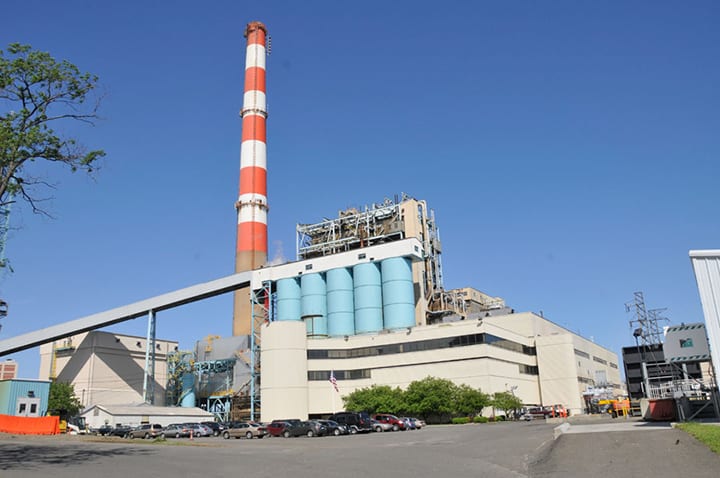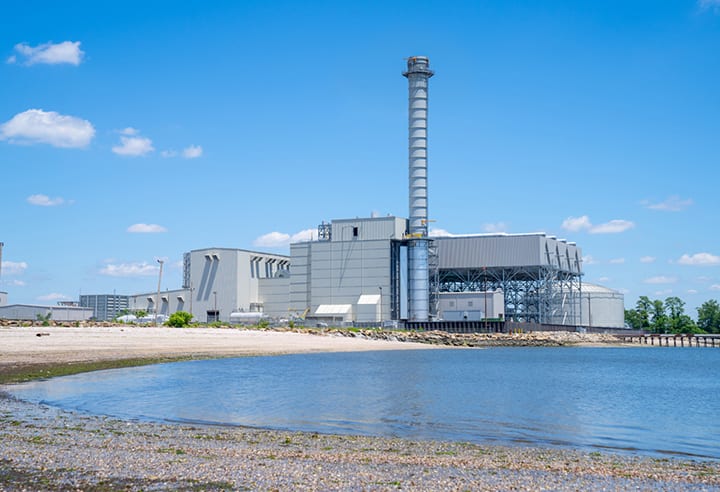PSEG Power retired its Bridgeport Harbor Station Unit 3 (BHS 3, Figure 1) on May 31. The unit, located in Bridgeport, Connecticut, was the last remaining coal-fired power plant in the company’s fleet.

“The retirement of Bridgeport Harbor Station Unit 3 marks the end of an era for the City of Bridgeport and the citizens who relied on its power,” Ralph Izzo, chairman, president, and CEO of Public Service Enterprise Group Inc. (PSEG Power’s parent company), said in a press release. “I’m grateful to the generations of employees who operated this unit safely and reliably for more than 50 years, and to the entire Bridgeport community for their support.”
BHS 3 was originally built as a 410-MW unit that could burn either oil or coal. In 2002, it was modified to operate on low-sulfur sub-bituminous coal, and the oil burning capability was decommissioned in 2015.
In June 2017, PSEG Power began construction on BHS Unit 5 (Figure 2), a new 485-MW combined-cycle unit, which the company invested more than $550 million into. BHS 5 is designed to operate primarily on natural gas, but it can also run on ultra-low-sulfur distillate (ULSD) as a backup fuel. Completion of the new unit in June 2019 signaled a major turning point for BHS 3, as its capacity was effectively replaced by the more-efficient and cleaner-operating combined-cycle unit.

In recent years, BHS 3 had only been operated during times of peak energy demand, such as extreme heat or cold. In fact, Unit 3 didn’t operate at all in 2019, and only operated for two days in 2020, according to PSEG Power. However, it was called upon in January and February this year, running nearly the entire time during a stretch of unusually cold weather.
“That remarkable run, even as the unit was just weeks from retiring permanently, reflects the readiness and determination of the entire Bridgeport Harbor 3 team, with support from BHS 5, New Haven and the entire PSEG Fossil organization,” Izzo said. “The team should be proud of its performance during this stretch, during which it maintained all safety and environmental standards without a single forced outage, injury or COVID 19-related issue.”
The Bridgeport facility could still see more changes by the end of the year as PSEG Power moves forward with a “Strategic Alternatives” initiative. When the plan was first rolled out on July 31, 2020, PSEG Power’s non-nuclear generating fleet included more than 6,750 MW of fossil generation located in New Jersey, Connecticut, New York, and Maryland, as well as a Solar Source portfolio that had 467 MW located in various states.
On May 5, PSEG revealed that it had entered into an agreement to sell the Solar Source portfolio to Quattro Solar, an affiliate of LS Power. In a press release announcing the deal, Izzo said, “This sale marks a key milestone in our Strategic Alternatives process as we continue our transformation into a primarily regulated utility. We also intend to continue our efforts to preserve our existing carbon-free nuclear fleet and to seek regional growth opportunities in offshore wind projects that fit with PSEG’s Powering Progress strategy.”
The company continues to explore divestiture options for its remaining fossil assets. Its goal is seemingly to have a fleet consisting of almost entirely carbon-free energy, including nuclear plants and new investments in offshore wind generation. It expects the process to be completed by the end of this year.
Concerning offshore wind, PSEG announced on April 12 that it had completed the acquisition of a 25% equity interest in Ocean Wind, a 1,100-MW offshore wind farm planned 15 miles off the coast of southern New Jersey. PSEG will partner with Ørsted to develop Ocean Wind, but there are likely to be additional offshore wind projects added in the future because New Jersey lawmakers have an ambitious goal of installing 7,500 MW of offshore wind capacity by 2035.
“From creating jobs and strengthening the economy to investing in infrastructure and bringing gigawatts of renewable energy to our coast, offshore wind is critical to New Jersey’s future,” Izzo said in a statement announcing the Ocean Wind transaction. “PSEG is pleased to close on its investment in Ocean Wind and looks forward to working with Ørsted to bring clean energy and new industry to the state.”
PSEG registered a big win for its nuclear fleet on April 27 when New Jersey’s Board of Public Utilities awarded Hope Creek and Salem Units 1 and 2—three New Jersey nuclear units that PSEG has a stake in—subsidies of $300 million per year for another three years. The first round of subsidies had been approved in 2019 for three years through a so-called “Zero Emission Certificate” program. Funding for the subsidies comes from a fee charged to all New Jersey electricity customers.
—Aaron Larson is POWER’s executive editor (@AaronL_Power, @POWERmagazine).










